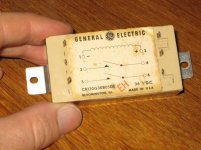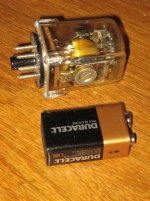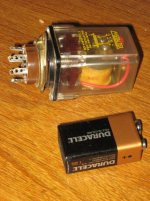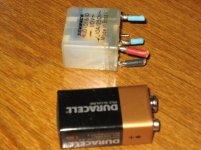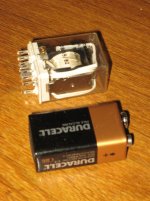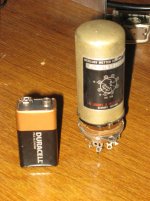Hi everyone,
I am planning to put speaker DC protection boards in my diy amps, which are class A solid state amps ranging from 8W Le Monstre to 25W Pass F5, possibly including muting on switch-on and switch-off. Following a couple of suggestions here on diyaudio I am looking into a couple of discrete circuits, including project P33 from Rod Elliott's ESP site, and a circuit based on the uPC1237 or something equivalent. (If I can get them). I'd be grateful for opinions on any of these, but that isn't the main reason for posting.
Partly because getting stuff imported here to Brazil in reasonable time and at a reasonable price is a struggle (...impossible...), and partly because I like using up old stuff, including junkbox heatsinks and so forth, I often look in the junkpiles at the Elec. Eng. department at the Univ. to see if they have stuff lying around I can use. In this case, the hard-to-find parts will be the relays, so I sorted out a plastic bag of relays to see if any of them would be suitable. Turns out I can't find out much on the internet (although loads of sites offer to *find* the part for me...) and the markings on some of these parts aren't very helpful, so I though I'd post some photos and info to see if anyone here can give opinions on probable current ratings, suitability for the job, and so forth...
Alternatively, any other interesting info about them...
So here goes. First up is a General Electric relay, marked as 36 VDC, code number CR120G30B05DE. Has two relays inside,one bobbin. This would be quite convenient in terms of physical size for one of my amps.
I am planning to put speaker DC protection boards in my diy amps, which are class A solid state amps ranging from 8W Le Monstre to 25W Pass F5, possibly including muting on switch-on and switch-off. Following a couple of suggestions here on diyaudio I am looking into a couple of discrete circuits, including project P33 from Rod Elliott's ESP site, and a circuit based on the uPC1237 or something equivalent. (If I can get them). I'd be grateful for opinions on any of these, but that isn't the main reason for posting.
Partly because getting stuff imported here to Brazil in reasonable time and at a reasonable price is a struggle (...impossible...), and partly because I like using up old stuff, including junkbox heatsinks and so forth, I often look in the junkpiles at the Elec. Eng. department at the Univ. to see if they have stuff lying around I can use. In this case, the hard-to-find parts will be the relays, so I sorted out a plastic bag of relays to see if any of them would be suitable. Turns out I can't find out much on the internet (although loads of sites offer to *find* the part for me...) and the markings on some of these parts aren't very helpful, so I though I'd post some photos and info to see if anyone here can give opinions on probable current ratings, suitability for the job, and so forth...
Alternatively, any other interesting info about them...
So here goes. First up is a General Electric relay, marked as 36 VDC, code number CR120G30B05DE. Has two relays inside,one bobbin. This would be quite convenient in terms of physical size for one of my amps.
Attachments
Just a little larger than the last one, this is a Metaltex (Brazilian brand) relay, marked OP3 RA1. They have loads of this brand, in one- two- and three-pole versions, with slightly different codes. As far as I can tell these are still actually new, in the box. The three-pole one is marked "6 V. A. C. " on the bobbin, the two pole one says "12-24 CC" and "900 ohms" on the box and on the bobbin, code OP2RCTR. They have dozens of these, so it would be cool if they are appropriate, or if they have some other interesting use.
All of these fit into tube/valve sockets. Were they originally for tube equipment?
All of these fit into tube/valve sockets. Were they originally for tube equipment?
Attachments
Try the dc protection / delay circuit in Erno Borbely's servo 50 article it works well
Thanks -I'll take a look.
I've got more photos, though! Smaller ones, both Brazilian made - the brand is called Schrack, but I don't know if that is itself Brazilian or not. The one on the left is a one=pole job, marked "10A 250V~", and "110V~" for the bobbin (DC ratings are lower than this, right?) but it looks a little dodgy, and I don't think they have another. They have dozens of the ones on the right - these appear to be four-pole, but look less hefty... Only info on the relay is the code 109P182N, if that means anything to anyone.
Attachments
afaik it is an Austrian one...sold to Siemens...sold to Tyco...the brand is called Schrack, but I don't know if that is itself Brazilian or not.
Regards
And last, but not least, the coolest of the lot, although maybe not very useful... Made by the Adams and Westlake Co., it's a single-pole relay in a steel case. Says "Mercury wetted contact relay" on the label, and has "DANGER - HIGH PRESSURE - DO NOT OPEN" on the other side. I can't imagine this is appropriate, or even safe, but I thought I'd include it just for kicks... 
OK, any info or suggestions about these relays (or circuits) would be very welcome.
Cheers
Nigel
OK, any info or suggestions about these relays (or circuits) would be very welcome.
Cheers
Nigel
Attachments
afaik it is an Austrian one...sold to Siemens...sold to Tyco...
Regards
Thanks. So probably made here under licence. Date on one of them is 1982, so they're doubtless long obsolete. Does anyone know of a source of info about them?
Cheers
Nigel
109p182 is a XEROX part number. I may have an old used one at home somewhere. I have been retired for some time now. so I "can't" get a new one. The coil is probably 24vdc the contacts I again can't remember. I may have used a similar relay in a tri amp chasis. I used 2 pole for the bass in parallel and single poles for the mid and treble amps. Stay away from the AC curent coils. You can use dc on an ac coil but not AC on a DC coil. Having replaced hundreds if not thousands of relays over the years especially the early years I have used an AC relay as a substitue for a DC relay till a proper spare was available. The Mercury relay is a fantastic find. You may have to operate the relay in a particular orientation, mercury is a liquid. Don't open it. The contact rating is generally lower for AC voltages because they are generally used at 110volts or 220 volts. DC contacts is usually rated at 24 or 48volts dc on the contacts. Get the highest curent rating for contacts. Use 2 24volt dc relays in series, for stereo, one for each channel. Most relays will energise at a lower voltage and hold the contacts closed at an even lower voltage. The hold voltage can be as low as 12volts on a 24volt dc relay. This reduces power in the relay and increases reliability. And the relay will deenergize quicker.
Thanks multisync, that's very helpful, although it does raise a few further questions which you may be able to answer. (I haven't used relays before so I may show my ignorance here and there, but there's no point in doing a safety circuit which doesn't work because you didn't ask the right questions, right?)
Any idea of the current rating on the 109p182? It's quite possible that Schrack made these parts as a supplier for Xerox, right? The other number on the same relay is RA 512900, does that ring any bells? Part of my difficulty with this one is the proliferation of connections on the bottom. It appears to be a four-pole relay (which matches your use of it you mention above) so I imagine the pins are in four groups of three, one group for each pole, with the last two for the coil. (Right?) From your last remark I udnerstand you thnk the other is an AC relay, but I can probably getaway with it if I want/need to.... correct?
This is all helpful info. Thanks. Not sure what to do about/with the mercury relay - it's only single pole so it's not much good unless they have another... Maybe I'll "drop in" tomorrow and take a look.... Do you have any idea what it was designed for?
No ideas on the Metaltex relays?
Cheers
Nigel
109p182 is a XEROX part number. I may have an old used one at home somewhere. I have been retired for some time now. so I "can't" get a new one. The coil is probably 24vdc the contacts I again can't remember. I may have used a similar relay in a tri amp chasis. I used 2 pole for the bass in parallel and single poles for the mid and treble amps. Stay away from the AC curent coils. You can use dc on an ac coil but not AC on a DC coil. Having replaced hundreds if not thousands of relays over the years especially the early years I have used an AC relay as a substitue for a DC relay till a proper spare was available.
Any idea of the current rating on the 109p182? It's quite possible that Schrack made these parts as a supplier for Xerox, right? The other number on the same relay is RA 512900, does that ring any bells? Part of my difficulty with this one is the proliferation of connections on the bottom. It appears to be a four-pole relay (which matches your use of it you mention above) so I imagine the pins are in four groups of three, one group for each pole, with the last two for the coil. (Right?) From your last remark I udnerstand you thnk the other is an AC relay, but I can probably getaway with it if I want/need to.... correct?
The Mercury relay is a fantastic find. You may have to operate the relay in a particular orientation, mercury is a liquid. Don't open it. The contact rating is generally lower for AC voltages because they are generally used at 110volts or 220 volts. DC contacts is usually rated at 24 or 48volts dc on the contacts. Get the highest curent rating for contacts. Use 2 24volt dc relays in series, for stereo, one for each channel. Most relays will energise at a lower voltage and hold the contacts closed at an even lower voltage. The hold voltage can be as low as 12volts on a 24volt dc relay. This reduces power in the relay and increases reliability. And the relay will deenergize quicker.
This is all helpful info. Thanks. Not sure what to do about/with the mercury relay - it's only single pole so it's not much good unless they have another... Maybe I'll "drop in" tomorrow and take a look.... Do you have any idea what it was designed for?
No ideas on the Metaltex relays?
Cheers
Nigel
I am at Work, yes I said I was retired, but I have a hobby job now and when I get home I will have a look at the junk box and read off the ratings. I am going over to a friend's to play with his pc that he is having problems with, so I may only get back to you on Friday morning.
Mercury wetted relay are for fast, low current switching where contact bounce must be eliminated - typically used in very old computers!
Metaltex still exist - : : : Metaltex : : :
Schrack as said are now part of Tyco - Schrack General Purpose and Power Relays - Tyco Electronics
as are Potter and Brumfield - Potter & Brumfield Relays - Datasheets - Tyco Electronics
Metaltex still exist - : : : Metaltex : : :
Schrack as said are now part of Tyco - Schrack General Purpose and Power Relays - Tyco Electronics
as are Potter and Brumfield - Potter & Brumfield Relays - Datasheets - Tyco Electronics
The 109p182 is a 24DC (coil) 4 pole double throw relay. Contacts are rated at 3amps at 110 volts AC and 3 amps at 28Volts dc.
If you find a 109p384 it looks exactly like the 109p182 and has similar ratings except it has a diode across the coil so be careful wiring it up.
If you can find a 109p397 that would be a good one as well, 24vDC on the coil and 10 amps on the contacts.
Just about every relay in the junk box has its ratings printed on it. Old Xerox stock or not.
If you find a 109p384 it looks exactly like the 109p182 and has similar ratings except it has a diode across the coil so be careful wiring it up.
If you can find a 109p397 that would be a good one as well, 24vDC on the coil and 10 amps on the contacts.
Just about every relay in the junk box has its ratings printed on it. Old Xerox stock or not.
Thanks for all the info, guys.
Now that would really be cool.... However, these relays must be pretty old, so I'm not sure whether it's a good idea to use them, from safety point of view. On the other hand I took a look, and there are four of them, so I COULD use them if I feel like walking on the wild side....
This is also a help, especially the last one. I took a look at that schrack link earlier yesterday, and they have no info (that I could find) on the relays I have on hand. The Metaltex site I had also looked at, but I didn't understand the codes on the relays - I thought they would work like part numbers on transistors and suchlike, but in fact you have to read them in steps. Once I did that I found a lot of information on them. Same basic idea worked with the Potter and B site, once you had me pointed in the right direction. Thanks.
Well, none of the ones I am looking at have all the ratings written on them unless you know how to read the codes, although some of them have some explicit info written elsewhere. Your info helps a lot, though. On the F5 I need to allow for a possible 24V offset with some catastrophic failure, so into an 8 ohm speaker a 3A relay is right at the limit. According to the ESP site (which seems to over-engineer things the way I like to) a +/- 40V supply requires a 10A relay to have a good safety margin, so following the same logic anything over about 6A should be OK for what I need. Of course you never find exactly what you want in a surplus/junk pile, and there don't appear to be any of the higher rated Xerox relays you mention, although that last one sounds like it would be perfect. The Potter and B and Metaltex relays, however, seem to rated at 12A, which is far bigger than I need, but maybe I should think of relays like heatsinks and transformers, where (up to a point) bigger is better...
There are various Metaltex relays (not only available, but in my car ) - all have contacts rated at 12A, with various DC ratings on the coils, but all reaonable. (22.5-50 VDC on one, 12-24 on another, and so forth). They all fit into 8 pin sockets (except the 3 pole ones, which I don't need for the time being.) and conveniently come in one-pole and two-pole models; perfect for monoblocs or stereo boxes.
) - all have contacts rated at 12A, with various DC ratings on the coils, but all reaonable. (22.5-50 VDC on one, 12-24 on another, and so forth). They all fit into 8 pin sockets (except the 3 pole ones, which I don't need for the time being.) and conveniently come in one-pole and two-pole models; perfect for monoblocs or stereo boxes.
So, I think I'm going to try a dc protection and muting board on the mini-aleph-J, using the circuits from P33 on the ESP site and the Metaltex two-pole relay, unless anyone has a better idea. If it goes well, a pair of boards for the F5.
Unless anyone thinks I should try the mercury-wetted jobs?? (I am so tempted.... "Hey, com hear my amp! It uses relays from ENIAC...")
Many thanks again for the help.
Cheers
Nigel
Mercury wetted relay are for fast, low current switching where contact bounce must be eliminated - typically used in very old computers!
Now that would really be cool.... However, these relays must be pretty old, so I'm not sure whether it's a good idea to use them, from safety point of view. On the other hand I took a look, and there are four of them, so I COULD use them if I feel like walking on the wild side....
Metaltex still exist - : : : Metaltex : : :
Schrack as said are now part of Tyco - Schrack General Purpose and Power Relays - Tyco Electronics
as are Potter and Brumfield - Potter & Brumfield Relays - Datasheets - Tyco Electronics
This is also a help, especially the last one. I took a look at that schrack link earlier yesterday, and they have no info (that I could find) on the relays I have on hand. The Metaltex site I had also looked at, but I didn't understand the codes on the relays - I thought they would work like part numbers on transistors and suchlike, but in fact you have to read them in steps. Once I did that I found a lot of information on them. Same basic idea worked with the Potter and B site, once you had me pointed in the right direction. Thanks.
The 109p182 is a 24DC (coil) 4 pole double throw relay. Contacts are rated at 3amps at 110 volts AC and 3 amps at 28Volts dc.
If you find a 109p384 it looks exactly like the 109p182 and has similar ratings except it has a diode across the coil so be careful wiring it up.
If you can find a 109p397 that would be a good one as well, 24vDC on the coil and 10 amps on the contacts.
Just about every relay in the junk box has its ratings printed on it. Old Xerox stock or not.
Well, none of the ones I am looking at have all the ratings written on them unless you know how to read the codes, although some of them have some explicit info written elsewhere. Your info helps a lot, though. On the F5 I need to allow for a possible 24V offset with some catastrophic failure, so into an 8 ohm speaker a 3A relay is right at the limit. According to the ESP site (which seems to over-engineer things the way I like to) a +/- 40V supply requires a 10A relay to have a good safety margin, so following the same logic anything over about 6A should be OK for what I need. Of course you never find exactly what you want in a surplus/junk pile, and there don't appear to be any of the higher rated Xerox relays you mention, although that last one sounds like it would be perfect. The Potter and B and Metaltex relays, however, seem to rated at 12A, which is far bigger than I need, but maybe I should think of relays like heatsinks and transformers, where (up to a point) bigger is better...
There are various Metaltex relays (not only available, but in my car
So, I think I'm going to try a dc protection and muting board on the mini-aleph-J, using the circuits from P33 on the ESP site and the Metaltex two-pole relay, unless anyone has a better idea. If it goes well, a pair of boards for the F5.
Unless anyone thinks I should try the mercury-wetted jobs?? (I am so tempted.... "Hey, com hear my amp! It uses relays from ENIAC...")
Many thanks again for the help.
Cheers
Nigel
- Status
- This old topic is closed. If you want to reopen this topic, contact a moderator using the "Report Post" button.
- Home
- Amplifiers
- Solid State
- Advice wanted on using old relays in DC protection circuits
